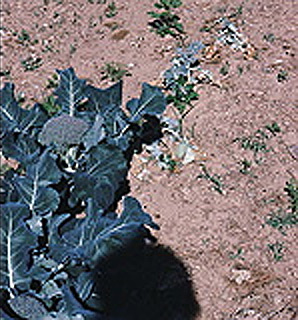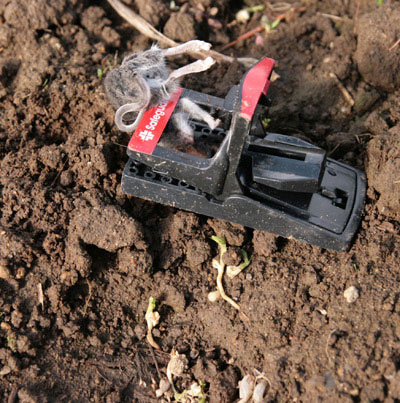Cabbage and onion maggots
Mice eating pea seeds
Cutworms
Onion sunscald
 |
| The row cover was about 10 feet too short and the cabbage maggot got the last few plants! |
CABBAGE AND ONION MAGGOT
(Reprinted and modified from The Umass Veg Notes)
Onion maggot (Delia antiqua) and cabbage maggot (Delia radicum) flies look nearly identical but are likely to be found only on or near their host crop. Cabbage root maggot attacks all types of Brassica crops, while onion maggots are highly specific for the onion family including onions, garlic, leeks, chives, and shallots. A good indicator of the start of cabbage root maggot flight is blooming of the common roadside weed, yellow rocket.
Life cycle: Onion and cabbage maggot flies spend the winter as small brown pupae in the soil. Adults emerge in spring and adults can travel considerable distances in search of host plants (1/2 to 1 mile). Cabbage root maggot flies are rather delicate, hump-backed gray-brown flies, about 5-7 mm long. Onion maggot flies are very similar. Female flies seek out their host crop to lay eggs at the base of the stem. Cool, moist soil conditions favor survival of the eggs, and soil temperatures over 95 F kill them. When the soil temperatures in the upper half to 1 inch are high (>95 degrees F) that soil temperature itself then provides control. A few years ago we reached these conditions in April, but it didn’t help because eggs were not yet present. These pests became a problem a bit later in the spring (early-mid May), as they usually do. Summer generations of the pest are rarely noticed because the survival in the warm soil is very low.
When eggs hatch, larvae feed on roots and can cause complete destruction of the root system. In crops such as broccoli or cauliflower the first sign of a problem is wilting of the plant on sunny days and yellowing of outer leaves. Later, plants collapse, wilt down, and die. If you pull one up you will see that the reason it is wilting is the roots are gone. You may find the legless white maggots feeding, or the small brown, oblong pupae. In Brassica root crops such as turnips, radishes and daikon, feeding tunnels make the root unmarketable.
In onions, newly hatched larvae crawl behind the leaf sheath and enter the tiny bulb, and feed on the roots, stem, and developing bulb. Feeding damage also encourages entry of soft rot pathogens.
Avoiding damage by later planting. The first flight and egg-laying period is generally most intense in the first half of May, depending on accumulated growing degree days – thus, it will vary with the season and location. After the first flight is over, and as soils heat up, fewer eggs are laid and those that are laid are less likely to survive. I have observed that in most years that Brassica transplants set out after the flowers fall from forsythia did not suffer damaging infestations of cabbage maggots. In cooler areas of the state, however, scouting has sometimes found damaging levels into June. Each season will be different. It is impossible to name a consistent and reliable date after which it is safe to plant onions or cole crops, but late May into June will likely be safer than the first half of May. By the way, if you find that your early May plantings of onions were hit hard, there would still be time to do another planting that would be less at risk. And, there would be time for many more plantings of brassica crops.
Monitoring. Flies are attracted to bright yellow colors. Yellow sticky cards (3X5 inches) are inexpensive and easy to use; attach them with small wire stakes and place near the soil. Check and change traps twice weekly to record changes in fly activity. (Sources: Great Lakes IPM, Gemplers)
Control
Floating row covers provide an effective barrier against these pests. Place the cover on as soon as the transplants are set. Use in a rotated field, as flies overwinter in soil after late season crucifers and could emerge under the cover. Replace cover after weeding operations. As soil temperatures rise and the first flight ends, and crops grow large, covers can be safely removed.
Crop rotation contributes to keeping populations low; greater distances are more effective, but remember that brassica weeds are also hosts. Fall tillage to bury crop residues and to expose over-wintering pupae is also useful. For onions, bury or haul away onion cull piles. Rotting onion smell attracts the onion maggot fly. In an vigorous Brassica crop, cultivation that brings soil up around the stem may help encourage formation of adventitious roots from the stem, which can help compensate for root loss even if maggots are present.
Naturally-occurring fungal diseases occasionally will reduce onion maggot numbers significantly, particularly when flies are abundant and relative humidity is high. During a fungal epidemic dead, diseased flies, can be seen clinging to the highest parts of plants along field edges. Predaceous ground beetles, which eat onion maggot eggs, larvae and pupae, can also be important in reducing maggot numbers.
Nematodes for biological control. One alternative method that has shown promise but has not been widely field-tested is soil application of entomopathogenic nematodes, especially Steinernema spp. Steinernema feltiae has been found to be more effective compared to other Steinernema or Heterorhabditis species in attaching to and penetrating cabbage root maggot larvae at low temperatures (10C) which is an important trait for use in spring when soils are cold. Common application methods include suspension of nematodes (infective juveniles) in water and application of water to transplants prior to setting in the field (as a spray or soaking drench), in transplant water used in the water wheel transplanter, as a drench after transplanting, or a combination of pre-plant and post-plant applications. Rates of 100,000 to 125,000 infective juveniles per transplant have been shown to be needed to achieve reduction in damage.
A seed treatment and baits with spinosad are being tested. A bait on the market now (Seduce) is marketed for cutworms (see below), but does not have maggots on the label.
Some Beneficial Nematode Suppliers:
The Green Spot: 603-942-8925 or www.shopgreenmethods.com
IPM Labs: 315-497-2093 or www.ipmlabs.com/
Arbico Organics: www.arbico-organics.com/
 |
| Trapped mouse. Note eaten pea seeds and remaining shoot. |
 |
| Cutworms around a broccoli seedling |
Mice love pea seeds. They eat them before they germinate and maybe leave a little hole. They pull up newly germinated seeds, eat what is left of it and leave the sprout laying there. Much of your seeding can be gone in days. If you have noticed this, it would be wise to set mouse traps along your rows of peas. Best bait? I use peanut butter. Does anyone have a better bait?
Cutworms are occasional pests of many crops early in the season, including carrots, peas, onions, spinach, broccoli and the list goes on and on. Some years they result in major losses, other years result in no loss at all. They are larvae of a dozen or so different species of night flying moths. They are greasy looking caterpillars that have a habit of curling into a “C” shape when disturbed. Most species that attack vegetables overwinter as partially grown larvae and so can become active very early in the spring when the plants first germinate and are very susceptible. Cutworms hide in the soil during the day and crawl on the surface at night. They feed and cut off young seedlings at the soil surface. During the day, you can dig around an inch or two deep around damaged plants and often find the ugly critter. Chickens love them.
Cultural Control
Since most species lay their eggs in the late summer/fall on vegetation, keeping fields clean of weeds and crops in the fall helps. Of course, this goes counter to the recommendations to keep the soil covered cropped, so it is a management decision based on how bad the problem has been. Fall plowing exposes larvae to birds. Cultivating fields in the spring just after vegetation has appeared and grown a few inches, and keeping it clean cultivated can starve the cutworms out before the peas go in. But, in must areas this is not practical because crops need to be planted.
On a small scale, collars built around each plant will keep the caterpillar away. Going out at night with a flash light and hand picking breakfast for your chickens can work.
Materials Approved for Organic Production
Entomopathogenic nematodes show good efficacy when environmental conditions are favorable. Steinernema carpocapsae has been shown to be very effective against cutworms, although reports are not specifically in pea production. Success with nematodes depends on proper application methods. Be sure to follow the instructions from the supplier carefully. A few suppliers of these insect-attacking nematodes are The Green Spot (www.greenmethods.com), IPM Laboratories (www.ipmlabs.com), and ARBICO (www.arbico.com).
Baits – Spinosad or Bt will kill the caterpillars, but getting the pest to consume the insecticide as a sprayed on material before significant damage is done is not likely. However, farmers and gardeners have reported good results using these materials in baits. The bait is spread on the ground near the plants, or prior to planting to clean out an area.
Spinosad – Seduce (OMRI Listed) is a commercial bait.
Bt – A bait made from Bt is often recommended and has received good reports from farmers. This is a method of use of Bt that is not described on the label. This off-label use is permitted by EPA under FIFRA 2ee, but growers should check with their state pesticide regulators about their state regulations. Make the bait by mixing the highest concentration solution of Bt allowed on the label and then mixing in a bit of molasses and alfalfa meal or bran. Then dampen this mix if necessary. Spread the bait along the planted or planned rows in the evening.
If you have delayed onion planting because things have not been right yet, or are replanting because the maggots got all the onions you put out earlier, then sunscald can be a problem. This is a problem that results from sudden hot weather. On hot sunny days the temperature at the soil surface gets very hot. The heat can damage sensitive young onion seedlings that are either just germinating or just set out as transplants. The injured tissue shrivels, strangling the neck right at the soil line, and the plant wilts and withers. The only way to avoid sunscald is to plant seed earlier in the spring so that the plants are beyond the sensitive stage before the soil temperature becomes too hot, or be lucky and not get hot sunny days when the tiny seedlings are sensitive.
